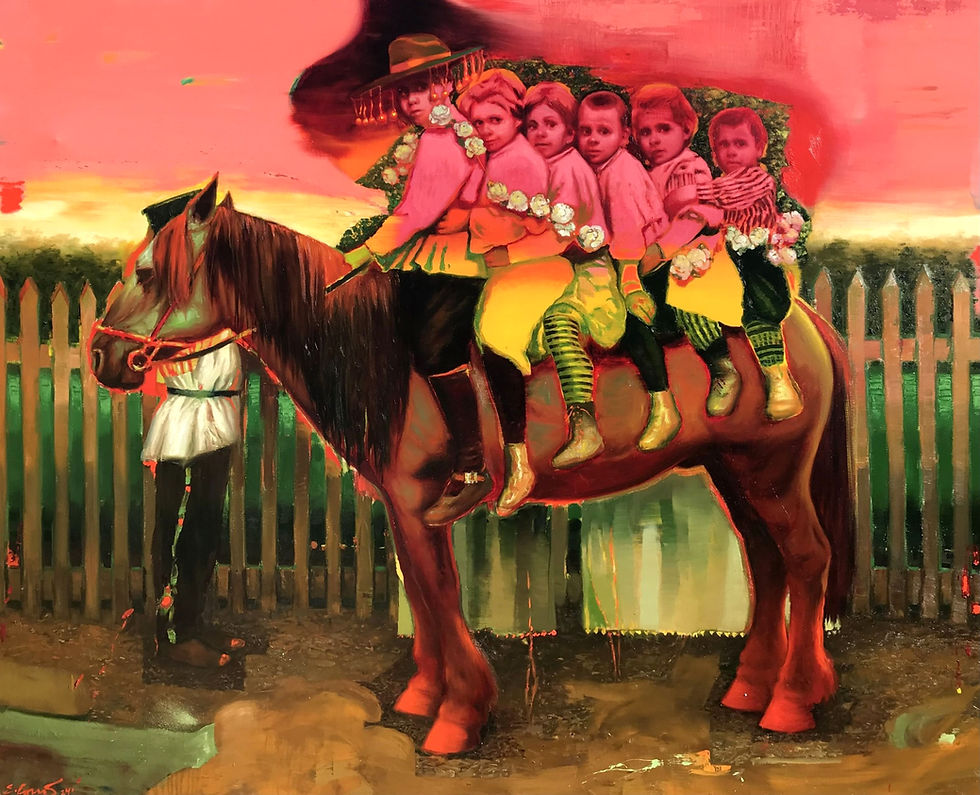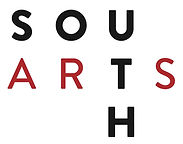
Edgar Cano, Ride on Dreams (2022). Oil on linen.

The 2025 South Arts Exhibition of the Southern Prize and State Fellows for Visual Arts
August 30th - November 2nd, 2025
The Southern Prize: Legacy and Innovation in Contemporary Southern Visual Art
By Shannon Rae Lindsey
“Objects have personal and cultural meaning because they absorb our stories and reflect our humanity back to us. My stories, your stories, our stories are held in the object.” - Sonya Clark, Visual Artist
How do we define art in the American South when it is difficult to categorize? It encompasses such a broad spectrum of artists, backgrounds, perspectives, and practices. However, any meaningful definition must consider both the historical and ongoing influence of vernacular traditions rooted in craft, storytelling, and place, and the contributions of contemporary artists whose work is conceptually driven and materially experimental. These approaches often navigate, intersect, or challenge conventional boundaries between the vernacular and the avant-garde, revealing the richness at the heart of Southern artistic expression.
The 2025 South Arts Southern Prize and State Fellowships for Visual Arts exhibition continues the rich history of the program’s celebration of diversity in media, subject matter, and conceptual investigations in Southern art. This year’s prize state fellows explore traditional materials through contemporary processes including ceramics, drawing, painting, quilting, and sculpture. They use a variety of mediums and methods to express their identities, environments, imaginations, narratives, and traditions to build their own frameworks to reflect on constructs throughout history and within the contemporary landscape. These artists actively explore a variety of concepts including: craft and process, complex histories and current issues, environments and communities, navigation of real and imagined spaces or real and imagined geographies; but all connect through a shared passion for connection, representation, and form. All of these artists’ works require an intimate experience of looking closely, visually tactile surfaces, and intentional traces of techniques and materials.
What does it mean to define Southern art when no single definition can fully capture its depth? Like the concept of Southerness itself, Southern art emerges from a rich tapestry of cultures, histories, and lived experiences—woven with threads of resilience, community, creativity, yet also by invisibility, struggle, and systemic oppression. These contradictions and nuances are what unites Southern artists, not fixed traits or styles, but shared values of persistence, resourcefulness, and the drive to transform adversity into expression. The nine 2025 South Arts Southern Prize State Fellows for Visual Arts are all rooted in the American South—whether by birth or by choice—and represent this shared dedication to storytelling, societal reflection, and creative resilience, offering diverse visions that discern the region’s past while imagining its future.
A fifth generation quilter from Gee’s Bend, the Alabama State Fellow, Loretta Pettway Bennett creates hand-stitched quilts through traditional approaches she learned from her mother. She honors her family’s traditions by embracing the inherent shape of on-hand fabrics to guide each quilt design. Embracing the principle of “using what you have,” Bennett transforms irregular scraps into striking designs that range from intuitive arrangements to complex geometric patterns.
The Florida State Fellow Gonzalo Fuenmayor creates large-scale, highly detailed, and dramatic charcoal drawings with rich black and white tonal variations. In his work, ornate symbols or ornamentation and decorative forms from the past collide with opposing contemporary elements. Through both additive and reductive techniques, he explores the complex impact of modernization on Latin American culture and environments—assimilating historical memory with present-day tension.
Georgia State Fellow Masela Nkolo grew up during the Congo Civil War, where he used screwdrivers both as tools of his trade and as weapons for personal protection. Today, he transforms those same tools—along with other mechanical and construction materials—into sculptures inspired by spiritual traditions. Deeply rooted in cultural memory and sacred symbolism, his works reinterpret ancestral forms through repurposed materials, bridging tradition and innovation to embody resilience and the journey from violence to healing.
Process-based sculptor and Kentucky State Fellow Travis Townsend constructs familiar yet playfully imaginative three-dimensional forms using accumulated and repurposed materials. His works begin with a sketched idea and intuitively evolve through layered techniques such as gluing, painting, joining, cutting, and reassembling. Embracing the joy and unpredictability of the creative process, Townsend reflects on the complexities of our built environment through forms that balance structure with spontaneity.
Louisiana State Fellow Edgar Cano creates paintings that blur the boundaries between lived experiences, memories, and dreams. His works blend real and imagined spaces and are often informed by photographic references. Drawing on his background in theatrical scene painting, Cano uses the human figure as a central element—animating space, embodying emotion, and implying narrative within plausible yet surreal environments that reveal the layered complexity of everyday life.
Clay-based artist and Mississippi State Fellow Stephen Phillips explores the interplay of contrasting base colors and glossy glazes on ceramic vessels through patterns of shapes and lines. His forms develop through a series of technical processes—including glazing, firing, and resist techniques—that build surface depth and reveal traces of previous layers. The final works, and the act of making them, reflect the journey of life itself—sometimes winding, layered, and shaped through moments of connection.
North Carolina State Fellow Lydia C. Thompson investigates and reflects on how humans occupy place and space in the past, present, and future. As a mixed-media artist specializing in ceramic sculpture, she assembles small strips of clay to create shelter-like forms with visual signs of decay and repair. The forms encourage reflection on human migration—what we build, what we destroy, what we abandon, and what we carry with us.
As a Black woman, South Carolina State Fellow Felicia Greenlee creates art to amplify her voice, which often goes unheard in America’s systemically racist society. She primarily works with wood to construct collaged portraits of Black individuals, inspired by historical events that converge with current issues. She reclaims the chain as a symbol of strength and endurance, and uses the target to draw the viewer face-to-face to the central figure—as if looking through a camera or a gun scope.
Through labor-intensive punch-needle embroidery, Tennessee State Fellow Tabitha Arnold creates tapestries that celebrate the working class in the United States. She incorporates symbols from the labor movement, art history, and Southern Christianity to contextualize the lived experiences of workers from the past, present, and future. Her densely layered compositions invite viewers to invest time in looking—an act that echoes the value and reward of sustained labor.
Photos by Diane Deaton Street
This exhibition is supported by:



GRETCHEN & ALDY MILLIKEN









